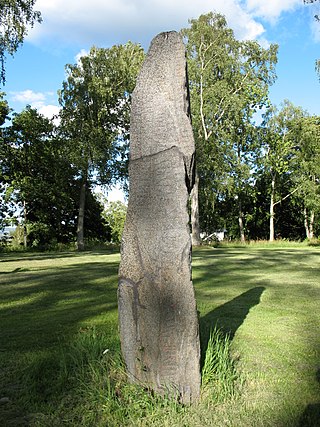Related Research Articles
In Māori mythology, the Ponaturi are a group of hostile creatures (goblins) who live in a land beneath the sea by day, returning to shore each evening to sleep. They dread daylight, which is fatal to them. They appear in a number of stories, including:

In Hawaiian mythology, Laka is the name of two different popular heroes from Polynesian mythology..

In Māori mythology, Matuku-tangotango (Matuku) is an ogre who kills Wahieroa the son of Tāwhaki. In some versions, Matuku lives in a cave called Putawarenuku. Rātā, the son of Wahieroa, sets off to avenge his murdered father, and arrives at last at Matuku's village. He hears from Matuku's servant that at the new moon his master can be killed at the pool where he washes his face and hair. When the new moon has come, Rātā waits until the ogre comes out of his cave and is leaning over with his head in the pool. He grabs him by the hair and kills him. Rātā then sets off to rescue his father's bones from the Ponaturi. A South Island version names the islands where Matuku lives as Puorunuku and Puororangi and also states that Rātā nooses Matuku as he comes out of his lair to perform certain rituals.
In Māori mythology, Wahieroa is a son of Tāwhaki, and father of Rātā.
In the mythology of Tahiti, Pua Tu Tahi was one of the giant monster clam of the deep in the legend of Rata.
Rata may refer to:
In Norse mythology, Élivágar are rivers that existed in Ginnungagap at the beginning of the world. The Prose Edda relates:
The streams called Ice-waves, those which were so long come from the fountain-heads that the yeasty venom upon them had hardened like the slag that runs out of the fire,-these then became ice; and when the ice halted and ceased to run, then it froze over above. But the drizzling rain that rose from the venom congealed to rime, and the rime increased, frost over frost, each over the other, even into Ginnungagap, the Yawning Void. Gylfaginning 5.
In the Tuamotu Rata cycle, Tahiti-tokerau was a water-nymph whom Vahi-vero marries. She was abducted by Puna, king of the underworld and rescued by her husband. They then become parents of Rata.
Manu-kura was a famous warrior in the Tuamotuan version of the Rata cycle of Polynesian mythology. His home was in the ocean.
Tumu-nui is the name of several figures in Tahitan mythology.
In Māori mythology, Matoka-rau-tāwhiri is a wife of Wahieroa, and mother of Rātā.

In Māori mythology, accounts vary somewhat as to the ancestry of Rātā. Usually he is a grandson of Tāwhaki and son of Wahieroa. Wahieroa is treacherously killed by Matuku-tangotango, an ogre. Rātā sets out to avenge the murder, travelling to the home of Matuku, where a servant of the ogre tells him that Matuku comes out to devour people each new moon, and that he can be killed at the pool where he washes his face and hair. Rātā waits till the ogre comes out and is leaning over with his head in the pool. He grabs him by the hair and kills him. Matuku's bones are used to make spears for hunting birds.
In the Tuamotu islands, the telling of the full cycle of the legend of Rata takes several evenings to tell.
Rata, in Tahitian mythology, is said to have become king of Tahiti when his uncle, king Tumu-nui, and his father Vahieroa are swallowed by a great clam while they are on their way to Pitcairn. When he reaches adulthood, Rata plans to avenge his father. As in the Tuamotuan version, Rata identifies a tree to build his canoe, but it is protected by forest elves. After he captures them they build it for him in a single night. While en route for Pitcairn, Rata and his crew are sucked down into the same clam, but they use their spears to cut the monster open. They rescue the remains of Rata's father and uncle and bury them back in Tahiti. After recovering from their adventure, Rata sets out for further adventures. See also Aremata-Popoa and Aremata-Rorua.
In Tuamotu mythology, Vahi-vero is the son of the demigod Kui and a goblin woman named Rima-roa.

The Saleby Runestone, designated as Vg 67 in the Rundata catalog, was originally located in Saleby, Västra Götaland County, Sweden, which is in the historic province of Västergötland, and is one of the few runestones that is raised in memory of a woman.
Kui was a chthonic demigoddess and the wife of Tuputupuwhenua in Māori mythology. They supposedly live underground and when a new house is built, a tuft of grass is offered to them.

Tahiti and Society Islands mythology comprises the legends, historical tales, and sayings of the ancient people of the Society Islands, consisting of Tahiti, Bora Bora, Raiatea, Huahine, Moorea and other islands. It is considered a variant of a more general Polynesian mythology, developing its own unique character for several centuries. The religion was officially suppressed in the 19th century, and ultimately abandoned by the natives in favor of Christianity.
In Greek mythology, Cymatolege was one of the 50 Nereids, sea-nymph daughters of the 'Old Man of the Sea' Nereus and the Oceanid Doris.
In Greek mythology Aea was a huntress of Colchis, who attracted the unwanted attention of a local river-god.
References
- ↑ Jan Knappert (1995). Pacific mythology : an encyclopedia of myth and legend. London: Diamond Books. p. 21.
- R.D. Craig, Dictionary of Polynesian Mythology (Greenwood Press: New York, 1989), 13-14;
- T. Henry, Ancient Tahiti (Bernice P. Bishop Museum: Honolulu, 1928), 470–495.